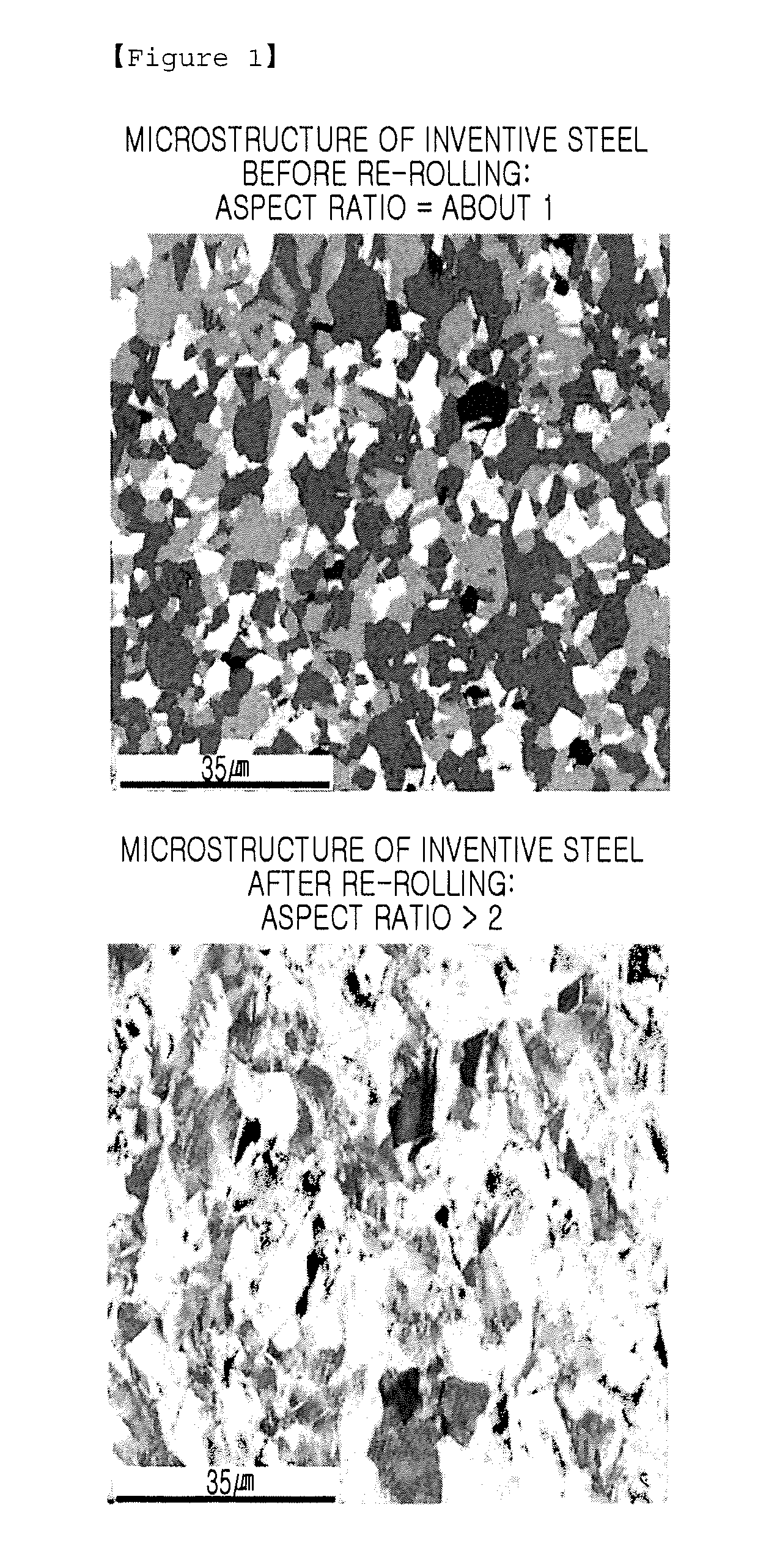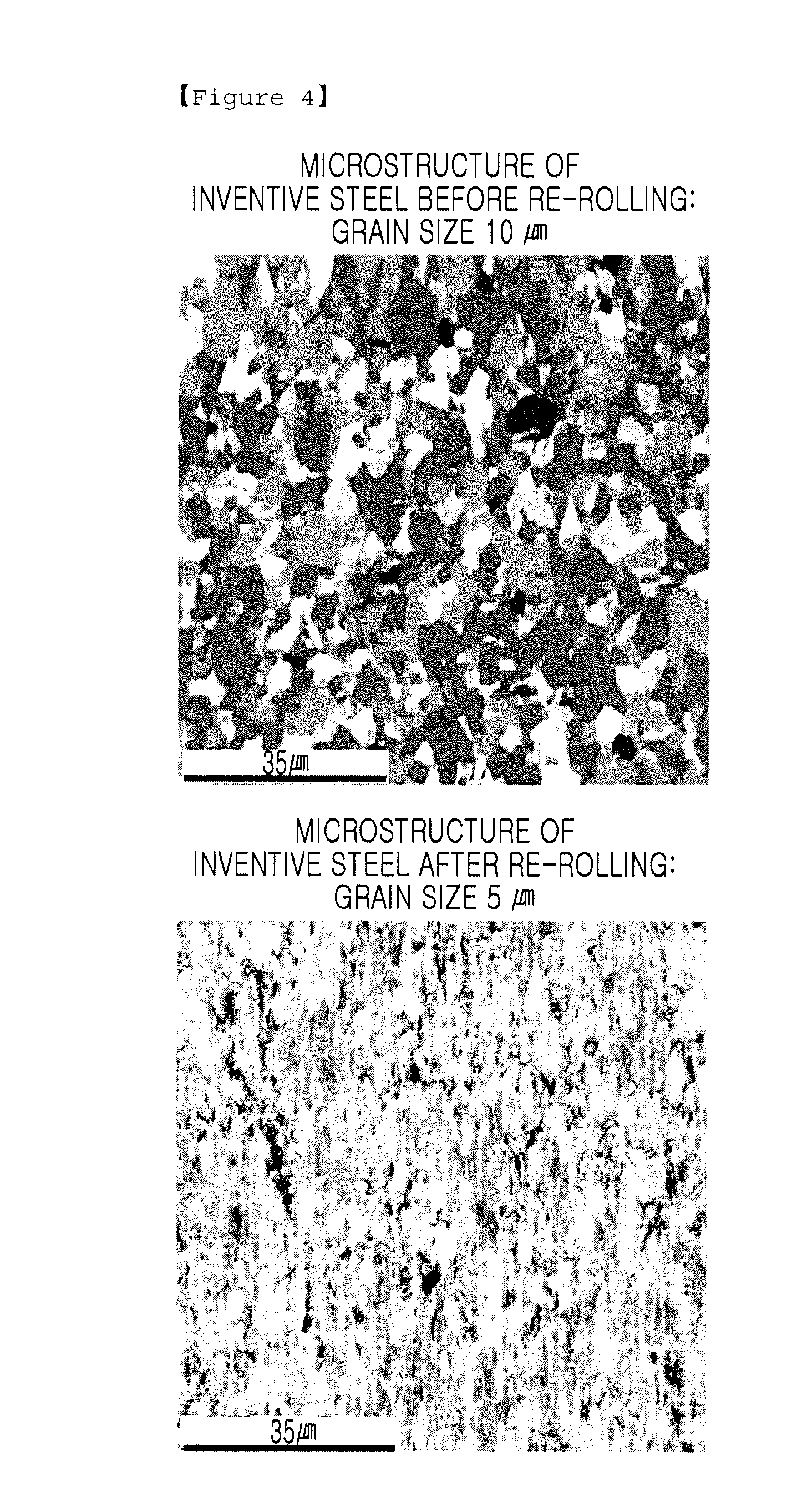Ultrahigh-strength steel sheet and manufacturing method therefor
a technology of ultrahigh-strength steel and manufacturing method, which is applied in the direction of manufacturing tools, furnaces, heat treatment equipment, etc., can solve the problems of affecting the quality and reducing the production efficiency of high-strength steel sheets. achieve the effect of high degree of strength and ductility, and induce work hardening
- Summary
- Abstract
- Description
- Claims
- Application Information
AI Technical Summary
Benefits of technology
Problems solved by technology
Method used
Image
Examples
example 1
[0086]Steel ingots having compositions as illustrated in Table 1 were maintained in a heating furnace at 1200° C. for one hour and were subjected to a hot rolling process to form hot-rolled steel sheets. At that time, the temperature of finish hot rolling was set to be 900° C., and after the hot rolling process, the hot-rolled steel sheets were coiled at 650° C. Thereafter, the hot-rolled steel sheets were pickled and were cold rolled at a reduction ratio of 50%. Next, samples of the cold-rolled steel sheets were heat treated at an annealing temperature of 800° C. and an overaging temperature of 400° C. to simulate a continuous annealing process, and were then re-rolled with reduction ratios as illustrated in Table 2 below.
[0087]After the cold-rolled steel sheets were re-rolled, a tension test was performed to measure mechanical characteristics of the re-rolled steel sheets such as strength and elongation according to reduction ratios, and results of the tension test are illustrated...
example 2
[0097]Steel ingots having compositions as illustrated in Table 3 were maintained in a heating furnace at 1200° C. for one hour and were subjected to a hot rolling process to form hot-rolled steel sheets. At that time, the temperature of finish hot rolling was set to be 900° C., and after the hot rolling process, the hot-rolled steel sheets were coiled at 650° C. Thereafter, the hot-rolled steel sheets were pickled and were cold rolled at a reduction ratio of 50%. Next, samples of the cold-rolled steel sheets were heat treated (continuously annealed) at an annealing temperature of 800° C. and an overaging temperature of 400° C. to simulate a continuous annealing process. In addition, after the cold-rolled steel sheets were heat treated as described above, a test for simulating a hot-dip galvanizing process was performed on the steel sheets using a hot-dip galvanizing bath adjusted to a temperature of 460° C. In addition, as described in the above example, the continuously annealed st...
example 3
[0109]Steel ingots having compositions as illustrated in Table 5 were maintained in a heating furnace at 1200° C. for one hour and were subjected to a hot rolling process to form hot-rolled steel sheets. At that time, the temperature of finish hot rolling was set to be 900° C., and after the hot rolling process, the hot-rolled steel sheet was coiled at 650° C. Thereafter, the hot-rolled steel sheets were pickled and were cold rolled at a reduction ratio of 50%. Next, samples of the cold-rolled steel sheets were heat treated at an annealing temperature of 800° C. and an overaging temperature of 400° C. to simulate a continuous annealing process. In addition, after the cold-rolled steel sheets were continuously annealed at 800° C. as described above, a test for simulating a hot-dip galvanizing process was performed on the steel sheets using a hot-dip galvanizing bath adjusted to a temperature of 460° C.
[0110]Thereafter, tension test samples were prepared from the cold-rolled steel she...
PUM
| Property | Measurement | Unit |
|---|---|---|
| grain size | aaaaa | aaaaa |
| yield strength | aaaaa | aaaaa |
| tensile strength | aaaaa | aaaaa |
Abstract
Description
Claims
Application Information
 Login to View More
Login to View More - R&D
- Intellectual Property
- Life Sciences
- Materials
- Tech Scout
- Unparalleled Data Quality
- Higher Quality Content
- 60% Fewer Hallucinations
Browse by: Latest US Patents, China's latest patents, Technical Efficacy Thesaurus, Application Domain, Technology Topic, Popular Technical Reports.
© 2025 PatSnap. All rights reserved.Legal|Privacy policy|Modern Slavery Act Transparency Statement|Sitemap|About US| Contact US: help@patsnap.com



